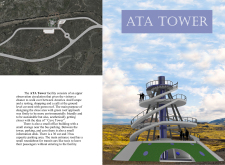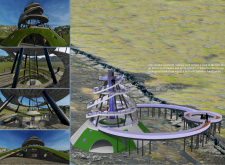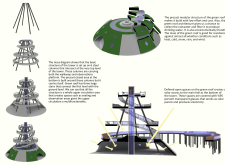5 key facts about this project
At its core, the project functions as a multi-purpose facility, blending residential, commercial, and recreational spaces to create a tapestry of activities that support a dynamic lifestyle. The layout is meticulously designed to facilitate seamless movement and interaction, ensuring that each area connects both visually and spatially. This thoughtfulness in design exemplifies the project’s commitment to enhancing user engagement and promoting a sense of community.
The architectural design features an innovative composition of materials that collectively contribute to its overall character. Elements such as reinforced concrete, aluminum panels, and expansive glazing have been thoughtfully selected not only for their aesthetic qualities but also for their performance. The use of these materials reflects a dedication to sustainability, as they are chosen for their durability, energy efficiency, and minimal environmental impact. The glazing, in particular, allows for natural light to permeate the interiors, reducing the need for artificial lighting and creating inviting spaces.
Attention to detail is evident throughout the project. The design includes carefully crafted transitions between indoor and outdoor areas, blurring the boundaries and allowing nature to become an integral part of the user experience. Balconies and terraces extend from the building, providing residents and visitors with outdoor spaces that encourage relaxation and social interaction. Landscaping plays a significant role in this design, with native plant species incorporated to enhance biodiversity and reduce maintenance needs, reflecting a broader commitment to ecological responsibility.
Unique design approaches are evident in the building's geometry and layout. The architect has skillfully manipulated shapes and volumes to create a dynamic silhouette that stands out within the urban fabric, while still respecting the scale of nearby structures. This negotiation between bold architectural expression and contextual sensitivity demonstrates a nuanced understanding of the environment. The incorporation of multiple rooflines and varied façade treatments adds depth and interest, inviting closer inspection and engagement from passersby.
Furthermore, the project introduces innovative sustainability strategies, such as rainwater harvesting systems and solar panel integration, which not only enhance the building’s ecological performance but also educate residents on the importance of sustainable living. These elements reflect a forward-thinking approach to architecture, emphasizing the role of design in addressing contemporary environmental challenges.
In summary, the project is a testament to thoughtful architecture, blending pragmatic functionality with aesthetic sensibility. The unique design ideas, material choices, and attention to community-oriented spaces establish a framework for living that is both practical and enriching. Readers interested in exploring this architectural endeavor further are encouraged to examine the project’s architectural plans, architectural sections, and detailed architectural designs to appreciate the full scope and intent behind these innovative architectural ideas. Engaging with these resources will provide deeper insights into how this project contributes to its environment and serves its community.


























